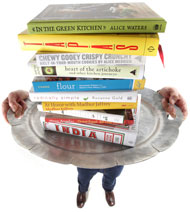 While walking through the splendorous Union Square Market yesterday, looking for new arrivals, I noticed small fragrant strawberries and the loveliest asparagus I've seen in a long time. Those strawberries would wind up in a wonderful dessert I had last night at abc kitchen (located just a few blocks from Union Square) -- a kind of strawberry compote decorated with tiny meringues and topped with a quenelle of sour cream-poppy seed ice cream.
But those asparagus, crisp and green and just the size I love -- not too thin and not too thick -- reminded me of "the recipe that made me famous." Way back in 1995 when no one was roasting asparagus, except for my friend Arthur Schwartz, nobody, and I mean nobody, was frying capers, except me! The resulting recipe for "Oven-Roasted Asparagus, Fried Capers" was to appear in Recipes 1-2-3: Fabulous Food Using Only Three Ingredients, published in 1996 by Viking. The headnote went like this: In less than ten minutes you can have the most addictive asparagus you've ever encountered. An intense dose of heat keeps these spears green and snappy. Deep-fried capers add a startling accent. A wonderful Mediterranean-inspired first course or side dish." (recipe below). This recipe would come to be a favorite of Ruth Reichl, the restaurant critic of the New York Times. Fifteen years later, in Radically Simple, I added a fourth ingredient -- fresh bay leaves -- which impart a mysterious perfume. Just this morning I decided to punch in "roasted asparagus and fried capers" into the humming Google search bar. There are millions (I exaggerate) of citings for this recipe -- with no mention of me or where the recipe came from. But now you know.
While walking through the splendorous Union Square Market yesterday, looking for new arrivals, I noticed small fragrant strawberries and the loveliest asparagus I've seen in a long time. Those strawberries would wind up in a wonderful dessert I had last night at abc kitchen (located just a few blocks from Union Square) -- a kind of strawberry compote decorated with tiny meringues and topped with a quenelle of sour cream-poppy seed ice cream.
But those asparagus, crisp and green and just the size I love -- not too thin and not too thick -- reminded me of "the recipe that made me famous." Way back in 1995 when no one was roasting asparagus, except for my friend Arthur Schwartz, nobody, and I mean nobody, was frying capers, except me! The resulting recipe for "Oven-Roasted Asparagus, Fried Capers" was to appear in Recipes 1-2-3: Fabulous Food Using Only Three Ingredients, published in 1996 by Viking. The headnote went like this: In less than ten minutes you can have the most addictive asparagus you've ever encountered. An intense dose of heat keeps these spears green and snappy. Deep-fried capers add a startling accent. A wonderful Mediterranean-inspired first course or side dish." (recipe below). This recipe would come to be a favorite of Ruth Reichl, the restaurant critic of the New York Times. Fifteen years later, in Radically Simple, I added a fourth ingredient -- fresh bay leaves -- which impart a mysterious perfume. Just this morning I decided to punch in "roasted asparagus and fried capers" into the humming Google search bar. There are millions (I exaggerate) of citings for this recipe -- with no mention of me or where the recipe came from. But now you know.
Some years later, in my book Healthy 1-2-3, I also did something no one had done with asparagus. For a lovely, and very healthy asparagus and orange salad, I boiled the peelings from the asparagus until they were al dente and topped the salad with my original "asparagus fettuccine" -- for it is exactly what it looked like! Just recently I noticed this idea in a new cookbook. But now that I've begun a practice of daily "meditation" and reflection, this stuff doesn't bother me at all. Enjoy!
The Original Recipe for Roasted Asparagus with Fried Capers (from Recipes 1-2-3)
2 pounds medium-size asparagus 4 tablespoons olive oil 1/4 cup large capers, drained
Preheat the oven to 500 degrees. Trim the stems of the asparagus, cutting off the ends to make even. Drizzle 2 tablespoons of the olive oil on a rimmed baking sheet. Place the asparagus on the pan and coat with the oil. Sprinkle lightly with salt. Roast for 8 minutes and transfer to a warm platter. Meanwhile, in a small skillet, heat the remaining 2 tablespoons oil. Fry the capers for 1 to 2 minutes until crispy. Pour over the asparagus and pass the pepper mill. Serves 6











